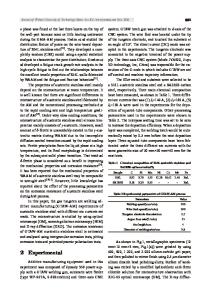Microstructure Evolution and Selective Corrosion Resistance in Underwater Multi-pass 2101 Duplex Stainless Steel Welding
- PDF / 6,961,834 Bytes
- 15 Pages / 593.972 x 792 pts Page_size
- 68 Downloads / 383 Views
INTRODUCTION
DUPLEX stainless steels (DSSs) can replace austenite stainless steels (ASSs) because they have the same corrosion resistance and are more cost effective. DSSs are being increasingly used as structural materials in various fields, such as nuclear power plants, marine construction, and the petrochemical industry.[1] The extraordinary properties of DSSs can be attributed to the phase balance of ferrite (a) and austenite (c) and the high contents of solute alloy elements such as Cr, Mo, and N.[2,3] In recent years, lean DSSs have been rapidly developed by adding Mn and N to replace Ni and Mo, which significantly reduces the cost but does not significantly affect the properties.[4] For example, 2101 DSS has replaced 304 ASS in the spent fuel pool of nuclear power plants.
YU HU, YONGHUA SHI, and XIAOQIN SHEN are with the School of Mechanical and Automotive Engineering, South China University of Technology, Guangzhou 510640, China and also with the Guangdong Provincial Engineering Research Center for Special Welding Technology and Equipment, South China University of Technology, Guangzhou 510640, China. Contact e-mail: [email protected] ZHONGMIN WANG is with the Guangxi Key Laboratory of Information Materials, Guilin University of Electronic Technology, Guilin 541004, China. Manuscript submitted December 28, 2017.
METALLURGICAL AND MATERIALS TRANSACTIONS A
Underwater welding has attracted considerable attention as a fundamental underwater joining method. Based on practical conditions, underwater welding can be performed by dry welding, wet welding, and local cavity welding methods.[5] DSS weld joints usually require a filler metal (FM) with a high Ni content to improve the unbalanced dual-phase microstructure resulting from the rapid cooling rate during welding.[6] Because of the unavailability of a specialized welding wire that can be directly used in water, application of underwater wet welding of DSS is limited by welding defects, such as porosity and cold cracks.[7,8] The quality of underwater local cavity welds is dependent on the design and manufacture of the drain hood, and the welding location. In contrast, dry welding completely eliminates the negative effects of water, and ensures that the welding quality is equivalent to that on land. Therefore, studying on the dry hyperbaric welding technology of 2101 DSS is significant to the reconstruction and repair of nuclear power plants. Almost all of the arc welding methods can be used for welding DSSs. During DSS welding, the phase balance is always disturbed because of the rapid cooling rate, as austenite transformation from ferrite is diffusion controlled. The secondary phase Cr2N can precipitate in the supersaturated ferrite containing N of the heat–affected zone (HAZ) and weld metal (WM) during the quick cooling process.[9,10] The regions around Cr2N precipitates are chromium depleted and prone to localized
corrosion.[11] Moreover, in multi-pass welding, the Cr2N precipitates dissolve and provide nucleation sites for secondary austenite (c2) as a functio
Data Loading...











